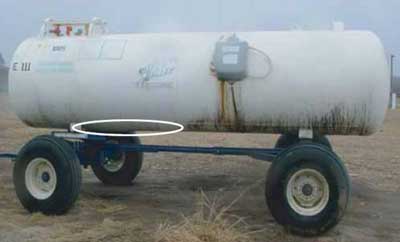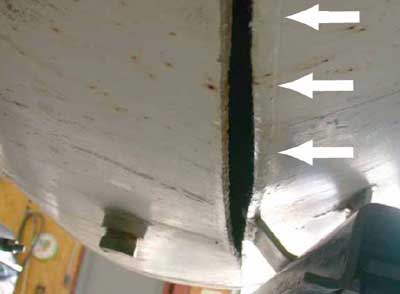Anhydrous Ammonia Nurse Tank Rupture Kills Agricultural Cooperative Worker
Iowa Case Report: 03IA027
Report Date: June 24, 2005
Summary
A 68-year-old male agricultural cooperative worker died from complications associated with injuries he sustained two weeks earlier when an anhydrous ammonia nurse tank ruptured in the spring of 2003. Just prior to the incident, the victim and a coworker had been filling four nurse tanks with liquefied anhydrous ammonia at a nurse tank refilling station. The victim had just finished filling and disconnecting the nurse tank from the anhydrous ammonia transfer system, when a seam at the base of the cylinder near the front split open, causing a rapid expansion, and subsequent explosion of the escaping anhydrous ammonia. The force from this event threw the coworker against a nearby pickup, and knocked him unconscious. The victim shut off the anhydrous ammonia transfer system and went to aid his fallen coworker.
Emergency response personnel arrived at the scene and stabilized the victim and coworker. Both men suffered chemical burns to more than 50 percent of their body surface area, and had eye and respiratory system injuries. The coworker survived his injuries but the victim died thirteen days later from complications associated with the incident: pneumonia due to inhalation burns.
 |
|
Photo 1 – The nurse tank with area of fracture site circled.
(Photograph courtesy of NTSB) |
Recommendations based on our investigation are as follows:
- Owners of liquefied anhydrous ammonia nurse tanks should institute periodic testing programs to ensure that the tanks remain structurally sound.
- Employers and operators should ensure that emergency response procedures are in place and utilized by workers to adequately protect them from hazards.
Introduction
A 68-year old male agricultural cooperative worker died from complications associated with injuries he sustained two weeks earlier when a liquefied anhydrous ammonia nurse tank ruptured at an agricultural cooperative’s bulk anhydrous ammonia storage facility. The Iowa FACE Program became aware of the incident immediately through a local television newscast. A FACE investigation was initiated when reports were received that one of the injured agricultural cooperative workers had died.
A nurse tank is a steel, cylindrical tank with hemispherical ends used for the transportation of anhydrous ammonia to farms where it is injected into the soil as fertilizer. Anhydrous ammonia is a gas at ambient temperature and atmospheric pressure, so it is compressed into a liquid state for transport. Because of the high pressures needed to maintain it as a liquid, it must be placed in specially designed tanks that can withstand internal pressures of at least 250 pounds per square inch (1.75 MPa). These tanks are formed by welding the seam of a steel plate that has been rolled into a cylinder. Steel hemispherical heads are then welded on each end of the cylinder to form the nurse tank. Subsequent investigation revealed that the rupture occurred in the weld seam of the cylinder behind the weld for the head end (Photo 2).
Initial calls were made to the Company, local ambulance/fire/rescue services, and to the county law enforcement agency. Investigations of the incident were underway by the Iowa Division of Labor Services Occupational Safety and Health Bureau (IOSHA) and the US National Transportation Safety Board (US NTSB). Because of these on-going investigations, the Company was reluctant to permit a site visit or allow FACE investigators to view the ruptured nurse tank. The IOSHA investigation of this incident concluded there were no violations of any occupational safety and health regulations. Sources of information for this investigation were official reports and interviews with representatives of the county law enforcement agency, fire/ambulance/rescue services, and State Medical Examiners Office plus local news reports and the US NTSB report.
The Company involved in this incident is a farmer-owned agricultural cooperative based in Iowa that has been in business for over 20 years. The Company specializes in supplying its 1,800 member-owners with fuels, livestock feed, crop nutrients, and pesticides. The Company operates eleven bulk anhydrous ammonia storage facilities in eastern Iowa and utilizes roughly 600 anhydrous ammonia nurse tanks in its fertilizer service. The Company has not had any fatalities previously.
 |
|
Photo 2– The underside of the nurse tank with close-up view of fracture site.
(Photograph courtesy of NTSB) |
Investigation
A 68-year-old male agricultural cooperative worker died from complications associated with injuries he sustained two weeks earlier when a liquefied anhydrous ammonia nurse tank ruptured. A nurse tank is a tubular steel vessel used to transport anhydrous ammonia, a chemical widely used as a fertilizer, injected into the ground to nourish crops.
The incident occurred at the agricultural cooperative’s bulk anhydrous ammonia storage facility and involved the release of approximately 1,300 gallons (4.9 cu m) of liquefied anhydrous ammonia: a poisonous, corrosive, liquefied gas with a boiling point of –28°F (-33°C). The victim and 23-year-old male coworker were alone at the storage facility. The weather conditions were approximately a temperature of 80°F (26°C), clear skies, and winds gusting 15 to 25 mph (24 to 30 kph).
The victim and coworker had been filling four nurse tanks with liquefied anhydrous ammonia at the facility’s nurse tank refilling station. This station was comprised of a raised wooden platform approximately 20 ft (6 m) wide by 20 ft (6 m) long and about 3 ft (1 m) above ground elevation. A network of interconnected pumps, pipes, and hoses enabled the simultaneous transfer of anhydrous ammonia from the facility’s bulk anhydrous ammonia storage tank to up to four individual nurse tanks. A water immersion tub was located in the center of the nurse tank refilling station and a second one was located roughly 40 ft (12 m) away, next to the facility’s bulk anhydrous ammonia storage tank. The victim had just finished filling and disconnecting the nurse tank from the anhydrous ammonia transfer system and was standing on the raised wooden platform monitoring the status of the three other nurse tanks at the refilling station. The coworker had backed a pickup truck up to the front of the nurse tank involved in the incident, and was at the back of the pickup truck hooking the pickup truck to the tongue of the nurse tank.
Abruptly and without forewarning, the nurse tank split open along a seam at the base of the cylinder near the front end. The pressure and rapid expansion of the escaping anhydrous ammonia created a very large, white, vapor cloud and several holes in the gravel lot underneath the ruptured nurse tank. The largest crater was roughly 7 ft (2 m) long, 5 ft (1.5 m) wide and 3 ft (0.9 m) deep. The explosion threw the coworker at the rear of the pickup truck against the pickup’s back end and knocked him unconscious. The victim shut off the anhydrous ammonia transfer systems by activating an emergency shutoff switch located in the center of the nurse tank refilling station and went to aid the fallen coworker. The victim moved the unconscious coworker to the center of the nurse tank refilling station and placed him in the immersion tub. The victim then began rinsing himself and the coworker with the water in the immersion tub.
A member of the agricultural cooperative happened to be passing by the facility at the time of the incident and saw the large, white, vapor cloud coming from the facility. This cooperative member immediately drove to the facility and saw the two workers in the immersion tub at the nurse tank refilling station. The passerby then went into the facility’s office and summoned emergency response personnel. Over the next few minutes several other people arrived at the scene and assisted the victim and coworker. It was during this interval that the victim entered the immersion tub with the unconscious coworker.
When the County Sheriff, fire department and ambulance/rescue service arrived at the scene, the visible anhydrous ammonia cloud had largely dissipated. The victim and coworker were stabilized at the scene. Their clothing was removed and they were washed with plenty of clean water. It was at this time that the coworker regained consciousness. Due to the extent of chemical burns to more than 50 percent of their body surface areas (eye injuries and inhalation injuries), both men were transported by helicopter to different regional hospitals for prompt attention. The coworker survived his injuries, but the victim died thirteen days later from complications associated with the incident: pneumonia due to inhalation burns.
Investigators were not able to interview the victim before his death due to the extent of the injuries he sustained in the incident. The victim did tell a person at the scene that he had activated the emergency shutoff button located at the center of the raised platform, deactivating the anhydrous ammonia transfer pump. The victim had been a seasonal laborer (spring and fall months) for the agricultural cooperative for the previous four years. The coworker had worked for the cooperative for approximately eight months.
Cause of Death
The cause of death according to the Medical Examiner was “respiratory insufficiency due to pneumonia and anhydrous ammonia burns.”
Recommendations/Discussion
Recommendation #1: Employers that operate liquefied anhydrous ammonia nurse tanks should institute periodic testing programs to ensure that the tanks are structurally sound.
Discussion: Currently, neither the Department of Transportation nor OSHA requires periodic inspection and testing of nurse tanks. However, given the catastrophic results from the failure of one of these tanks, the National Transportation Safety Board recommended that periodic, non-destructive testing be conducted to identify material flaws that could develop during a tank’s service life and result in tank failure. A template for inspection could be derived from the requirements for other cargo tanks that carry anhydrous ammonia. This inspection schedule is as follows: external visual inspection and leak testing annually, internal visual inspection and pressure testing every five years.
Recommendation #2: Employers should ensure that emergency response procedures are in place and utilized by workers to adequately protect them from hazards.
Discussion: NIOSH recommends that when an anhydrous ammonia release occurs, workers should “immediately vacate the area by heading upwind”(1) It is recommended that people should move at least 200 ft (60 m) away from the source to decrease the inhalation exposure. Immersion tanks are effective in decreasing the effects to the skin, but are not effective in decreasing the inhalation damage. It is imperative that employees be made aware of all the health hazards of working with anhydrous ammonia, and be trained in appropriate emergency response procedures should a release occur.
References
- Thomas McKelvey, HAZOP of Anhydrous Ammonia Use in Agriculture, prepared for NIOSH by Technica, Inc., Columbus, Ohio, May 1991.
- National Transportation Safety Board, Office of Research and Engineering, Materials Laboratory Division. Materials Laboratory Factual Report, Report No. 03-093. Washington, D.C.
- National Transportation Safety Board. Nurse Tank Failure With Release of Hazardous Materials Near Calamus, Iowa, April 15, 2003. Hazardous Materials Accident Report, NTSB/HZM-04/01. Washington, D.C.
Iowa FACE Program
Fatality Assessment and Control Evaluation, FACE, is a program of the National Institute for Occupational Safety and Health (NIOSH), which is part of the Centers for Disease Control and Prevention of the U.S. Department of Health and Human Services. Nationally, the FACE program identifies traumatic deaths at work, conducts in-depth studies of select work deaths, makes recommendations for prevention, and publishes reports and alerts. The goal is to prevent occupational fatalities across the nation.
The NIOSH head office in Morgantown, West Virginia, carries out an intramural FACE case surveillance and evaluation program and also funds state-based programs in several cooperating states. In Iowa, The University of Iowa through its Injury Prevention Research Center works in conjunction with the Iowa Department of Public Health and its Office of the State Medical Examiner to conduct the Iowa FACE program.
Nationally, NIOSH combines its internal information with that from cooperating states to provide information in a variety of forms which is disseminated widely among the industries involved. NIOSH publications are available on the web at https://www.cdc.gov/NIOSH/FACE/ and from the NIOSH Distribution Center (1-800-35NIOSH).
Iowa FACE also publishes its case studies, issues precautionary messages, and prepares articles for trade and professional publication. In addition to postings on the national NIOSH web site, this information is posted on the Iowa FACE site. Copies of FACE case studies and other publications are available by contacting Iowa FACE, too.
The Iowa FACE team consists of the following specialists from the University of Iowa: Craig Zwerling, MD, PhD, MPH, Principal Investigator; John Lundell, MA, Co-Investigator; Murray Madsen, MBA, Chief Trauma Investigator; and Co-Investigator/specialists Risto Rautiainen, PhD, and Wayne Sanderson, PhD, CIH. Additional expertise from the Iowa Department of Public Health includes Rita Gergely, Principal Investigator, and John Kraemer, PA, from the Office of the State Medical Examiner.
To contact Iowa State FACE program personnel regarding State-based FACE reports, please use information listed on the Contact Sheet on the NIOSH FACE web site. Please contact In-house FACE program personnel regarding In-house FACE reports and to gain assistance when State-FACE program personnel cannot be reached.

